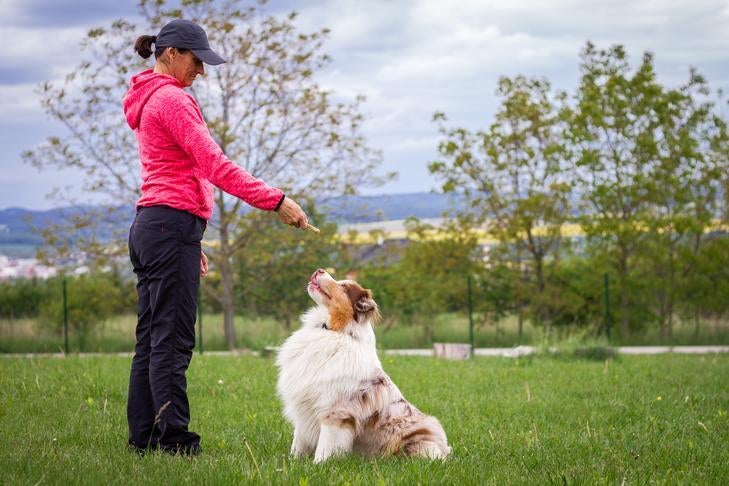Puppy behavioral training tailored to your dog’s learning style.
Puppy behavioral training tailored to your dog’s learning style.
Blog Article
Leading Canine Training Tips for a Well-Behaved Companion
Training your pet dog to be a well-behaved buddy requires a nuanced understanding of canine habits and the execution of efficient strategies. The journey to a genteel animal involves more than simply these fundamentals; it requires a much deeper exploration of methods that can change your training approach.
Comprehending Pooch Behavior
Comprehending canine actions is important for reliable dog training and promoting an unified relationship between pet dogs and their proprietors. Dogs are complex creatures, showing a wide variety of actions influenced by genetics, atmosphere, and socializing. Acknowledging the underlying inspirations for a pet's actions-- such as concern, exhilaration, or territorial impulses-- can significantly boost training efficiency.
Observing body language is a crucial facet of recognizing canine actions. Tail placement, ear orientation, and stance can offer important understandings into a pet dog's psychological state. For instance, a wagging tail does not constantly indicate joy; it can likewise signify agitation or anxiousness. Moreover, social interactions with other canines and people play a crucial duty in forming actions. Pet dogs that experience favorable socializing are normally much more adaptable and genteel.

Important Training Commands
Grasping essential training commands is crucial for establishing efficient communication in between pets and their proprietors. These commands work as the structure for a well-behaved canine and can substantially boost the total partnership between pet and proprietor.
Trick commands consist of "Sit," "Keep," "Come," "Down," and "Heel." The command "Sit" is frequently the first instructed, as it encourages peace and emphasis. "Stay" reinforces a canine's ability to remain in one position, promoting self-control. "Come" is important for safety, making certain that your pet returns to you when called. "Down" instructs your pet to relax, which can assist in taking care of ecstatic habits. Dog training near me. "Heel" teaches your dog to stroll along with you, promoting better leash good manners.
Exercising these commands in various atmospheres aids canines generalize their training and react suitably, regardless of disturbances. By investing time in showing these important commands, proprietors can cultivate an unified and considerate connection with their canine companions, enhancing both safety and security and satisfaction in daily interactions.
Favorable Support Methods
Favorable reinforcement methods are important methods in canine training that concentrate on rewarding preferred habits to urge their recurrence. This method leverages the all-natural knowing processes of pets, allowing them to link certain activities with favorable end results. By utilizing deals with, appreciation, or playtime as rewards, trainers can successfully inspire dogs to duplicate the behaviors they intend to enhance.
To carry out favorable support, it is essential to deliver benefits right away after the wanted actions takes place. This aids the pet make a clear link in between their action and the incentive. Uniformity is also vital; benefits must be offered every time the preferred habits is exhibited during the initial training stage, progressively transitioning to a variable timetable as the actions ends up being extra trusted.
Recognizing your canine's choices can boost the training experience. Inevitably, positive support cultivates a trusting partnership between the pet dog and proprietor, making training a more enjoyable and reliable process that develops a mannerly companion.

Socialization Approaches
Efficient socialization approaches are critical for a canine's advancement, as they assist develop a well-shaped and confident friend. Early exposure to different atmospheres, individuals, and various other animals is necessary to protect against behavior concerns in the adult years. Begin this procedure throughout the essential socializing duration, which normally takes place between 3 and fourteen weeks old.
Introduce your puppy to varied stimulations, such as various surface areas, appears, and scents. Regulated experiences with various other pets and pleasant humans can cultivate positive organizations. Pup courses are an exceptional resource, offering organized settings for social communication and discovering basic commands.
Gradually raise the intricacy of socialization experiences. Take your dog to parks, pet-friendly shops, and public occasions, ensuring each encounter declares. Observe your pet's responses and remove them from frustrating circumstances to avoid fear-based responses.
Make use of positive reinforcement to compensate calm and confident actions during social communications. This might involve deals with, appreciation, or play. Remember, persistence is key; each pet home dog has its own rate for getting used to new experiences. By carrying out these socialization approaches, you lay the groundwork for a well-adjusted and sociable canine companion.
Uniformity and Routine
Developing consistency and routine in pet training is important for promoting a sense of protection and understanding in your pet. Canines thrive on predictability; understanding what to expect assists them really feel secure and lowers anxiousness.
Incorporating an organized regimen right into your training sessions additionally boosts your dog's learning experience - Dog training near me. Schedule daily training sessions at the same time each day, guaranteeing that both you and your canine are psychologically prepared. Short, regular training sessions are more effective than long, irregular ones; objective for 5 to 10 minutes of focused training multiple times a day
Furthermore, uniformity should prolong beyond formal training sessions. Incorporate training right into day-to-day tasks-- award your dog for sitting prior to dishes or strolling smoothly on a leash. This reinforces found out actions and develops a cohesive training atmosphere. Overall, a regular approach, combined with an organized routine, lays the foundation for a mannerly friend, advertising get redirected here an unified find out this here relationship in between you and your pet dog.
Conclusion
Finally, efficient dog training depends on understanding canine actions and executing essential commands such as "Sit," "Keep," and "Come." Positive reinforcement strategies serve to urge desired actions, while early socializing prepares dogs for varied settings. Establishing uniformity and a routine fosters predictability, which adds to a well-behaved friend. By emphasizing these crucial elements, the bond in between proprietor and canine reinforces, ultimately bring about an unified and meeting relationship.
Report this page